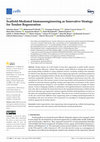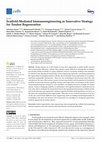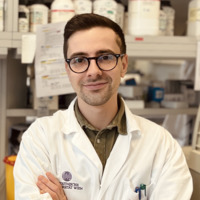Papers by Giuseppe Prencipe
Cells, Apr 24, 2024
This article is an open access article distributed under the terms and conditions of the Creative... more This article is an open access article distributed under the terms and conditions of the Creative Commons Attribution (CC BY

Frontiers in Veterinary Science
There is high clinical demand for the resolution of tendinopathies, which affect mainly adult ind... more There is high clinical demand for the resolution of tendinopathies, which affect mainly adult individuals and animals. Tendon damage resolution during the adult lifetime is not as effective as in earlier stages where complete restoration of tendon structure and property occurs. However, the molecular mechanisms underlying tendon regeneration remain unknown, limiting the development of targeted therapies. The research aim was to draw a comparative map of molecules that control tenogenesis and to exploit systems biology to model their signaling cascades and physiological paths. Using current literature data on molecular interactions in early tendon development, species-specific data collections were created. Then, computational analysis was used to construct Tendon NETworks in which information flow and molecular links were traced, prioritized, and enriched. Species-specific Tendon NETworks generated a data-driven computational framework based on three operative levels and a stage-dep...

Biomedicines
Tendon tissue engineering aims to develop effective implantable scaffolds, with ideally the nativ... more Tendon tissue engineering aims to develop effective implantable scaffolds, with ideally the native tissue’s characteristics, able to drive tissue regeneration. This research focused on fabricating tendon-like PLGA 3D biomimetic scaffolds with highly aligned fibers and verifying their influence on the biological potential of amniotic epithelial stem cells (AECs), in terms of tenodifferentiation and immunomodulation, with respect to fleeces. The produced 3D scaffolds better resemble native tendon tissue, both macroscopically, microscopically, and biomechanically. From a biological point of view, these constructs were able to instruct AECs genotypically and phenotypically. In fact, cells engineered on 3D scaffolds acquired an elongated tenocyte-like morphology; this was different from control AECs, which retained their polygonal morphology. The boosted AECs tenodifferentiation by 3D scaffolds was confirmed by the upregulation of tendon-related genes (SCX, COL1 and TNMD) and TNMD protei...

Cells, 2022
Tendon disorders represent a very common pathology in today’s population, and tendinopathies that... more Tendon disorders represent a very common pathology in today’s population, and tendinopathies that account 30% of tendon-related injuries, affect yearly millions of people which in turn cause huge socioeconomic and health repercussions worldwide. Inflammation plays a prominent role in the development of tendon pathologies, and advances in understanding the underlying mechanisms during the inflammatory state have provided additional insights into its potential role in tendon disorders. Different cell compartments, in combination with secreted immune modulators, have shown to control and modulate the inflammatory response during tendinopathies. Stromal compartment represented by tenocytes has shown to display an important role in orchestrating the inflammatory response during tendon injuries due to the interplay they exhibit with the immune-sensing and infiltrating compartments, which belong to resident and recruited immune cells. The use of stem cells or their derived secretomes withi...

Cells, 2022
Tendon injuries are at the frontier of innovative approaches to public health concerns and sector... more Tendon injuries are at the frontier of innovative approaches to public health concerns and sectoral policy objectives. Indeed, these injuries remain difficult to manage due to tendon’s poor healing ability ascribable to a hypo-cellularity and low vascularity, leading to the formation of a fibrotic tissue affecting its functionality. Tissue engineering represents a promising solution for the regeneration of damaged tendons with the aim to stimulate tissue regeneration or to produce functional implantable biomaterials. However, any technological advancement must take into consideration the role of the immune system in tissue regeneration and the potential of biomaterial scaffolds to control the immune signaling, creating a pro-regenerative environment. In this context, immunoengineering has emerged as a new discipline, developing innovative strategies for tendon injuries. It aims at designing scaffolds, in combination with engineered bioactive molecules and/or stem cells, able to modu...

Cells, 2021
Electrospun poly(lactic-co-glycolic acid) (PLGA) scaffolds with highly aligned fibers (ha-PLGA) r... more Electrospun poly(lactic-co-glycolic acid) (PLGA) scaffolds with highly aligned fibers (ha-PLGA) represent promising materials in the field of tendon tissue engineering (TE) due to their characteristics in mimicking fibrous extracellular matrix (ECM) of tendon native tissue. Among these properties, scaffold biodegradability must be controlled allowing its replacement by a neo-formed native tendon tissue in a controlled manner. In this study, ha-PLGA were subjected to hydrolytic degradation up to 20 weeks, under di-H2O and PBS conditions according to ISO 10993-13:2010. These were then characterized for their physical, morphological, and mechanical features. In vitro cytotoxicity tests were conducted on ovine amniotic epithelial stem cells (oAECs), up to 7 days, to assess the effect of non-buffered and buffered PLGA by-products at different concentrations on cell viability and their stimuli on oAECs’ immunomodulatory properties. The ha-PLGA scaffolds degraded slowly as evidenced by a s...

Molecular Reproduction and Development
Mitochondrial DNA (mtDNA) plays a crucial role in the development of a competent oocyte. Indeed, ... more Mitochondrial DNA (mtDNA) plays a crucial role in the development of a competent oocyte. Indeed, mtDNA alterations may predispose to chromosome nondisjunction, resulting in infertility due to a reduced vitality and quality of oocytes and embryos. In this methods paper, the multiple displacement amplification approach was applied in combination with next‐generation sequencing (NGS) to amplify and sequence, in single‐end, the entire mtDNA of single human oocytes to directly construct genomic NGS libraries, and subsequently, to highlight and quantify the mutations they presented. The bioinformatic workflow was carried out with a specific ad hoc developed in‐house software. This approach proved to be sensitive and specific, also highlighting the mutations present in heteroplasmy, showing deletion, insertion or substitution mutations in the genes involved in the respiratory chain, even if the found variants were benign or of uncertain meaning. The analysis of mtDNA mutations in the oocyte could provide a better understanding of specific genetic abnormalities and of their possible effect on oocyte developmental competence. This study shows how this approach, based on a massive parallel sequencing of clonally amplified DNA molecules, allows to sequence the entire mitochondrial genome of single oocytes in a short time and with a single analytical run and to verify mtDNA mutations.

Biomedicine, 2022
Tendon tissue engineering aims to develop effective implantable scaffolds, with ideally the nativ... more Tendon tissue engineering aims to develop effective implantable scaffolds, with ideally the native tissue’s characteristics, able to drive tissue regeneration. This research focused on fabricating tendon-like PLGA 3D biomimetic scaffolds with highly aligned fibers and verifying their influence on the biological potential of amniotic epithelial stem cells (AECs), in terms of tenodifferentiation and immunomodulation, with respect to fleeces. The produced 3D scaffolds better resemble native tendon tissue, both macroscopically, microscopically, and biomechanically. From a biological point of view, these constructs were able to instruct AECs genotypically and phenotypically. In fact, cells engineered on 3D scaffolds acquired an elongated tenocyte-like morphology; this was different from control AECs, which retained their polygonal morphology. The boosted AECs tenodifferentiation by 3D scaffolds was confirmed by the upregulation of tendon-related genes (SCX, COL1 and TNMD) and TNMD protein expression. The produced constructs also prompted AECs’ immunomodulatory potential, both at the gene and paracrine level. This enhanced immunomodulatory profile was confirmed by a greater stimulatory effect on THP-1-activated macrophages. These biological effects have been related to the mechanotransducer YAP activation evidenced by its nuclear translocation. Overall, these results support the biomimicry of PLGA 3D scaffolds, revealing that not only fiber alignment but also scaffold topology provide an in vitro favorable tenodifferentiative and immunomodulatory microenvironment for AECs that could potentially stimulate tendon regeneration.

Cells, 2022
Tendon injuries are at the frontier of innovative approaches to public health concerns and sector... more Tendon injuries are at the frontier of innovative approaches to public health concerns and sectoral policy objectives. Indeed, these injuries remain difficult to manage due to tendon’s poor healing ability ascribable to a hypo-cellularity and low vascularity, leading to the formation of a fibrotic tissue affecting its functionality. Tissue engineering represents a promising solution for the regeneration of damaged tendons with the aim to stimulate tissue regeneration or to produce functional implantable biomaterials. However, any technological advancement must take into consideration the role of the immune system in tissue regeneration and the potential of biomaterial scaffolds to control the immune signaling, creating a pro-regenerative environment. In this context, immunoengineering has emerged as a new discipline, developing innovative strategies for tendon injuries. It aims at designing scaffolds, in combination with engineered bioactive molecules and/or stem cells, able to modulate the interaction between the transplanted biomaterial-scaffold and the host tissue allowing a pro-regenerative immune response, therefore hindering fibrosis occurrence at the injury site and guiding tendon regeneration. Thus, this review is aimed at giving an overview on the role exerted from different tissue engineering actors in leading immunoregeneration by crosstalking with stem and immune cells to generate new paradigms in designing regenerative medicine approaches for tendon injuries.

Cells, 2022
Tendon disorders represent a very common pathology in today’s population, and tendinopathies that... more Tendon disorders represent a very common pathology in today’s population, and tendinopathies that account 30% of tendon-related injuries, affect yearly millions of people which in turn cause huge socioeconomic and health repercussions worldwide. Inflammation plays a prominent role in the development of tendon pathologies, and advances in understanding the underlying mechanisms during the inflammatory state have provided additional insights into its potential role in tendon disorders. Different cell compartments, in combination with secreted immune modulators, have shown to control and modulate the inflammatory response during tendinopathies. Stromal compartment represented by tenocytes has shown to display an important role in orchestrating the inflammatory response during tendon injuries due to the interplay they exhibit with the immune-sensing and infiltrating compartments, which belong to resident and recruited immune cells. The use of stem cells or their derived secretomes within the regenerative medicine field might represent synergic new therapeutical approaches that can be used to tune the reaction of immune cells within the damaged tissues. To this end, promising opportunities are headed to the stimulation of macrophages polarization towards anti-inflammatory phenotype together with the recruitment of stem cells, that possess immunomodulatory properties, able to infiltrate within the damaged tissues and improve tendinopathies resolution. Indeed, the comprehension of the interactions between tenocytes or stem cells with the immune cells might considerably modulate the immune reaction solving hence the inflammatory response and preventing fibrotic tissue formation. The purpose of this review is to compare the roles of distinct cell compartments during tendon homeostasis and injury. Furthermore, the role of immune cells in this field, as well as their interactions with stem cells and tenocytes during tendon regeneration, will be discussed to gain insights into new ways for dealing with tendinopathies.

Molecular Reproduction Development, 2022
Mitochondrial DNA (mtDNA) plays a crucial role in the development of a competent oocyte. Indeed, ... more Mitochondrial DNA (mtDNA) plays a crucial role in the development of a competent oocyte. Indeed, mtDNA alterations may predispose to chromosome nondisjunction, resulting in infertility due to a reduced vitality and quality of oocytes and embryos. In this methods paper, the multiple displacement amplification approach was applied in combination with next‐generation sequencing (NGS) to amplify and sequence, in single‐end, the entire mtDNA of single human oocytes to directly construct genomic NGS libraries, and subsequently, to highlight and quantify the mutations they presented. The bioinformatic workflow was carried out with a specific ad hoc developed in‐house software. This approach proved to be sensitive and specific, also highlighting the mutations present in heteroplasmy, showing deletion, insertion or substitution mutations in the genes involved in the respiratory chain, even if the found variants were benign or of uncertain meaning. The analysis of mtDNA mutations in the oocyte could provide a better understanding of specific genetic abnormalities and of their possible effect on oocyte developmental competence. This study shows how this approach, based on a massive parallel sequencing of clonally amplified DNA molecules, allows to sequence the entire mitochondrial genome of single oocytes in a short time and with a single analytical run and to verify mtDNA mutations.

Frontiers in Veterinary Science, 2023
There is high clinical demand for the resolution of tendinopathies, which affect mainly adult ind... more There is high clinical demand for the resolution of tendinopathies, which affect mainly adult individuals and animals. Tendon damage resolution during the adult lifetime is not as effective as in earlier stages where complete restoration of tendon structure and property occurs. However, the molecular mechanisms underlying tendon regeneration remain unknown, limiting the development of targeted therapies. The research aim was to draw a comparative map of molecules that control tenogenesis and to exploit systems biology to model their signaling cascades and physiological paths. Using current literature data on molecular interactions in early tendon development, species-specific data collections were created. Then, computational analysis was used to construct Tendon NETworks in which information flow and molecular links were traced, prioritized, and enriched. Species-specific Tendon NETworks generated a data-driven computational framework based on three operative levels and a stagedependent set of molecules and interactions (embryo–fetal or prepubertal) responsible, respectively, for signaling differentiation and morphogenesis, shaping tendon transcriptional program and downstream modeling of its fibrillogenesis toward a mature tissue. The computational network enrichment unveiled a more complex hierarchical organization of molecule interactions assigning a central role to neuro and endocrine axes which are novel and only partially explored systems for tenogenesis. Overall, this study emphasizes the value of system biology in linking the currently available disjointed molecular data, by establishing the direction and priority of signaling flows. Simultaneously, computational enrichment was critical in revealing new nodes and pathways to watch out for in promoting biomedical advances in tendon healing and developing targeted therapeutic strategies to improve current clinical interventions.

Cells, 2021
Electrospun poly(lactic-co-glycolic acid) (PLGA) scaffolds with highly aligned fibers (haPLGA) rep... more Electrospun poly(lactic-co-glycolic acid) (PLGA) scaffolds with highly aligned fibers (haPLGA) represent promising materials in the field of tendon tissue engineering (TE) due to their characteristics in mimicking fibrous extracellular matrix (ECM) of tendon native tissue. Among these properties, scaffold biodegradability must be controlled allowing its replacement by a neo-formed native tendon tissue in a controlled manner. In this study, ha-PLGA were subjected to hydrolytic degradation up to 20 weeks, under di-H 2 O and PBS conditions according to ISO 10993-13:2010. These were then characterized for their physical, morphological, and mechanical features. In vitro cytotoxicity tests were conducted on ovine amniotic epithelial stem cells (oAECs), up to 7 days, to assess the effect of non-buffered and buffered PLGA by-products at different concentrations on cell viability and their stimuli on oAECs’ immunomodulatory properties. The ha-PLGA scaffolds degraded slowly as evidenced by a slight decrease in mass loss (14%) and average molecular weight (35%), with estimated degradation half-time of about 40 weeks under di-H 2 O. The ultrastructure morphology of the scaffolds showed no significant fiber degradation even after 20 weeks, but alteration of fiber alignment was already evident at week 1. Moreover, mechanical properties decreased throughout the degradation times under wet as well as dry PBS conditions. The influence of acid degradation media on oAECs was dose-dependent, with a considerable effect at 7 days’ culture point. This effect was notably reduced by using buffered media. To a certain level, cells were able to compensate the generated inflammation-like microenvironment by upregulating IL-10 gene expression and favoring an anti-inflammatory rather than pro-inflammatory response. These in vitro results are essential to better understand the degradation behavior of ha-PLGA in vivo and the effect of their degradation by-products on affecting cell performance. Indeed, buffering the degradation milieu could represent a promising strategy to balance scaffold degradation. These findings give good hope with reference to the in vivo condition characterized by physiological buffering systems.











Uploads
Papers by Giuseppe Prencipe